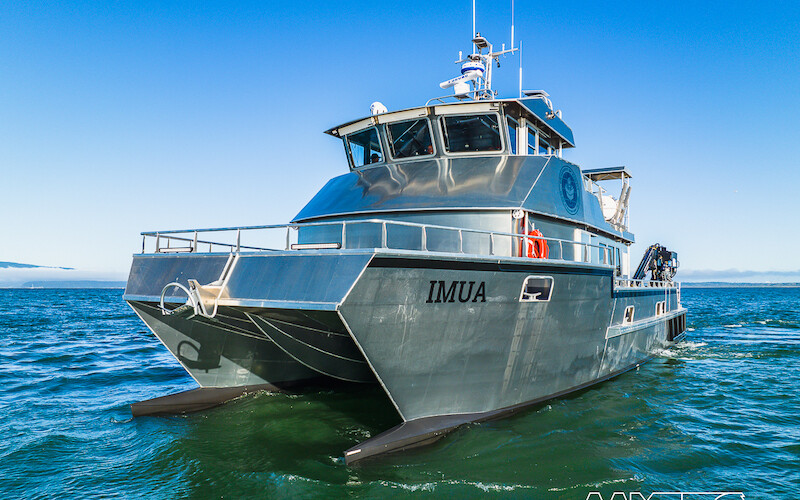All American Marine (AAM) and the University of Hawai’i at Mānoa have announced the delivery of a new research vessel.
The vessel will conduct research on behalf of the Hawaii Institute of Marine Biology (HIMB). The IMUA is a 68.5'x25' semi-displacement aluminum catamaran hull that was developed by Nic de Waal of Teknicraft Design, Auckland, New Zealand. The vessel contains proven design elements found in the recently commissioned research vessels Blue Manta and Shearwater built for BlueTide Puerto Rico and Duke University, respectively.
The vessel was built to Coast Guard standards and will operate as a multipurpose research vessel in Hawaiian waters and offshore on ocean routes. The knowledge gained from science missions on this vessel will directly support the management and conservation of Hawai’i’s marine resources.
The new research vessel integrates the signature Teknicraft Design symmetrical and asymmetrical combined hull shape, bow wave piercer, and a patented hydrofoil-assisted hull design. The hull and hull components are designed to break up wave action and ensure reduced drag while enhancing passenger comfort.
Teknicraft’s hydrofoil-assisted hull design is proven to have low-wake wash energy and fuel economy, shipyard officials said. The main foil action reduces the power needed to maintain service speed; therefore, fuel consumption and running costs are reduced significantly, while also further enhancing the softness of the ride, especially in choppy seas.
Teknicraft’s hydrofoil system consists of the main foil spanning the tunnel at the keel. The vessel also included transom mounted Humphree interceptors. The lift produced by the hydrofoil reduces the hull resistance while increasing speed and load-bearing capability, while the interceptors offer additional trim control.
This hull shape was custom designed using digital modeling and computational fluid dynamics (CFD) analysis testing. The vessel is designed to provide a smooth ride and comfort, as the hull provides a cushioned effect when encountering waves.
For the operator, a key feature of the vessel is the fuel economy, while also maintaining an estimated fully laden cruise speed of 22-24 knots and with a fuel-efficient minimum survey speed of 3 knots.
With a large fuel capacity of 1,800 gals., the design will support a science team of eight on offshore multiday missions and 22 students/crew on shorter day excursions.
The propulsion package includes twin Scania DI16, 082M, Tier 3 engines, rated at 800 hp at 2,100 rpm, connected to two fixed pitch propellers
Onboard the vessel, scientists and crew have comfortable live-aboard quarters, large state-of-the-art wet and dry lab spaces, as well as a range of the latest oceanographic equipment in which to conduct a variety of missions.
“From the beginning, we had productive discussions with All American Marine. This allowed them to understand exactly what we wanted from this vessel,” Carl Meyer, fellow of the Institute of Biology (UK) and University of Hawai’i researcher, said in a statement. “I'm very impressed at her speed and handling, even with all our scientific payload on board. Our opportunities to conduct research in certain oceanic areas around Hawaii are contingent on fairly good sea conditions. The ability to get to these remote places quickly with IMUA means considerably more opportunities to leverage weather using this vessel compared to a traditional, rather slow research platform.”
“All American Marine remains committed to being on the leading edge of manufacturing techniques and an innovator in merging the latest technology into a functional and proven vessel,” said Ron Wille, All American marine president and COO. “We are thrilled to have built this multi-mission research vessel and put it into action. It paves the way for a new era of ocean conservation and research capabilities.”





